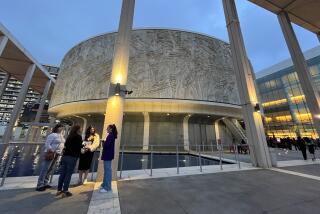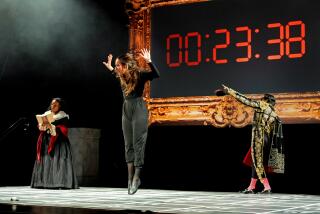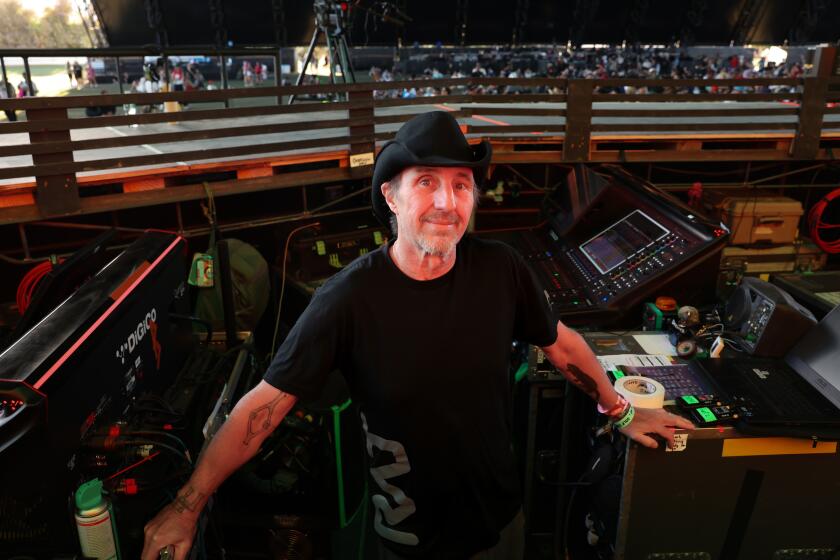‘Ring’ technicians prepare for the final catastrophe
It goes by many names: Armageddon, the apocalypse, Ragnarok, the End of the World. In show business, it’s sometimes referred to as the money shot — the climactic scene in which directors unleash a tidal wave of visual effects to conjure the mother of all earthly catastrophes.
The opera world isn’t known for its heart-stopping action sequences, but it does have its equivalent of a Michael Bay/Roland Emmerich moment at the end of Richard Wagner’s “Götterdämmerung,” the final chapter of the composer’s four-opera cycle “The Ring of the Nibelung.”
For 15 minutes, the stage rattles and rolls with the seismic upheaval of a self-destructing world. In Los Angeles Opera’s production, the scene represents an extraordinary logistical challenge that brings together a devilish combination of high-tech and low-tech stagecraft.
Jeff Kleeman, L.A. Opera’s technical director, says the scene is one of the most complicated that he’s worked on in his years at the company. “It’s about keeping all of our plates spinning and keeping everything moving in time,” he said.
The climactic scene is a visual and musical orgasm that arrives after nearly 17 hours of dramatic foreplay. Brünnhilde, the former Valkyrie, takes a suicidal leap onto the fiery funeral pyre of her mortal lover, Siegfried. The Rhine River overflows its banks and Valhalla, the home of the Gods, bursts into flames.
Pulling off the scene at the Dorothy Chandler Pavilion requires a team of 50 stage technicians executing no fewer than 32 cues (not including actor calls), most of which come in the hectic final seven minutes of the opera.
To evoke the floating bodies in the overflowing Rhine, crew members are responsible for lifting extras into the air via an old-fashioned system of ropes and pulleys. Each flying character requires one technician to control the up-down movement and a second person to control the right-left movement. (Puppets are also used to increase the total body count.)
The flames of Valhalla are completely digital. A translucent scrim, which is present throughout all four operas, serves as a screen for the 18 digital projectors situated around the theater. To create the conflagration, artists used Cinema 4D, a visual-effects software from Maxon Computer that is commonly employed in Hollywood movie productions.
L.A. Opera has stated that the cost of the video hardware and software alone is around $750,000. For the entire “Ring” cycle, digital artists worked for three years to put together close to 400 video cues.
The “Katastoph” scene — which is how L.A. Opera’s crew refers to the production’s final seven minutes — is nowhere near as technically daunting as the recent “Ring” in Valencia, Spain, which is regarded as one of the most innovative interpretations for its nonstop blitz of big-screen digital effects.
For L.A., director Achim Freyer conceived the opera’s final sequence as a Brechtian peeling away of stage artifice to reveal the inner workings of the production.
As the scene unfolds, audiences can see parts of the stagehouse that normally remain hidden, such as lighting fixtures and moving beams. At one point, a pair of raven cut-outs that have been stationary for most of the opera are lifted away to reveal the prompters — the invisible assistants who provide cues to the performers on stage.
Lyla Forlani, a production stage manager whose job includes calling out the technical cues during performances, described the scene as “pretty damn complicated,” adding that “it’s hard just to get all the words out.”
Forlani acts as a virtual air-traffic control operator for the opera, speaking into a headset and watching over four monitors that give her views of the stage and conductor James Conlon. During one performance of “Götterdämmerung,” the cut-out ravens failed to ascend on command.
“You do a lot of problem solving on the spot,” Forlani said. “In that case, we didn’t know what went wrong and decided to just move on. It was one of those problems that the audience probably didn’t notice.”
Technicians who have worked on the production said that the director tinkered with the sequence until the final dress rehearsals.
The entire scene plays out on the production’s steeply raked platform, which has been criticized by some cast members, that is made even more treacherous by a deliberately cluttered mise-en-scene. Competing for stage space amid the Brechtian swirl are the Rhine Maidens, the villainous Hagen, the corpse of Siegfried and a chorus of Gibichungs waving their lightsabers.
It all makes for a strange but arresting spectacle — a visual crescendo that concludes on a chaotic fortissimo.
“It’s a puzzle piece that has to be timed perfectly,” said Yuval Sharon, an assistant stage manager on the “Ring.” “It demands a lot of coordination and that’s what makes it so complicated.”
More to Read
The biggest entertainment stories
Get our big stories about Hollywood, film, television, music, arts, culture and more right in your inbox as soon as they publish.
You may occasionally receive promotional content from the Los Angeles Times.







